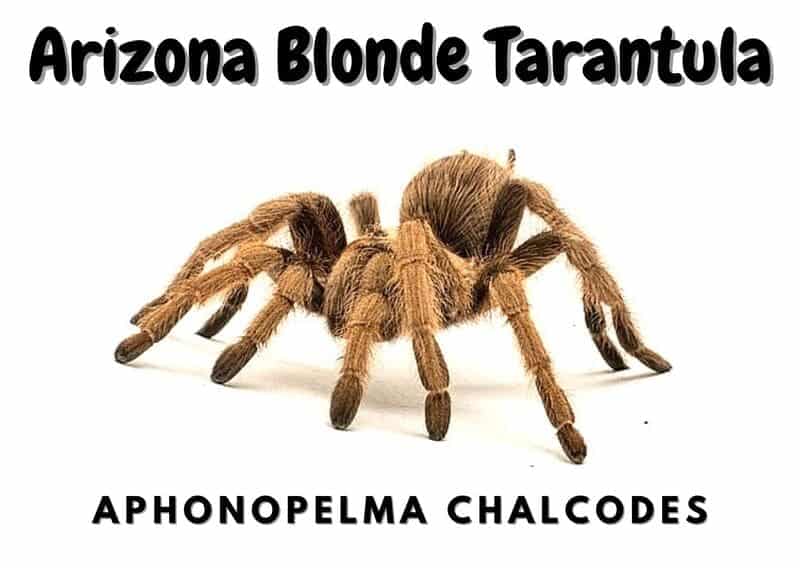Another crowd-pleaser in spider-collecting circles is the Arizona blonde tarantula. This species from the Valentine state known for the Grand Canyon also features its very own feisty spider. If you like a little spunk with touching beauty and grace, get ready to meet the Arizona blond.
Arizona Blonde Tarantula Overview
| Scientific Name | Aphonopelma Chalcodes |
| Dwelling | Terrestrial |
| Size | 5-6 inches |
| Lifespan | 5-10 years (male) / 25-30 years (female) |
| Food | mealworms, superworms, locusts, roaches, crickets |
| Difficulty | Beginner |
Aphonopelma chalcodes- Discovered by Ralph Vary Chamberlin (1940) This species was found in the saguaro-dominated plant communities of the southwestern US deserts.
Characteristics of the Arizona Blonde Tarantula
Coloration will vary between the male and female Arizona Blonde. Females will be lighter in color and display a golden-blond carapace. The cephalothorax connecting leg segments will be a dark brownish-black coloring. The rest of the leg segments will be a bushy blond color. Her abdomen will feature blond hair that grows darker at the base of the carapace.
Males are darker in hue and have almond-colored carapaces. The upper leg connecting at the cephalothorax will be darker brownish-black also. The lower parts of their legs will differ in the tinting of electric-blue iridescent colors. Foot tips can be lighter or darker as well. Upper legs may also have an iridescent sheen likewise. Males can either have an abdomen that comes in three colors.
One is a dark brown-black dusted with lighter-colored hairs that grow lighter toward the spinnerets. Another has a very electric blue coloration towards the spinnerets and a darker color inside next to the carapace. The last version has rusty red hairs blending thicker toward the spinnerets and a darker carapace connection point.
Size
Female Aphonopelma Calcodes can reach up to 5-6 inches 13-15cm) with a diagonal leg span of 6 inches (15cm). The mature body length is 2.75 inches (7cm) on average but can be larger over time. Males are much smaller with longer-skinnier legs. Females will appear thicker overall. Young slings will measure ¼ inch in length.
Temperament of the Arizona Blonde Tarantula
Oddball behavior to be expected can include flicking their urticating hairs in defense. They will like to bolt away in another direction to flee. This is never good since they might be in your hand and fall to the ground.
If they feel nervous or upset they go into a defensive pose raising their abdomen and getting ready to flick hairs. Care should be made when you are cleaning their habitat at all times due to their skittish nature.
Lifespan
Here is another great reason to own the female of this species. She can live up to 30 years, outlasting your pet dog twice over! The males also live longer but ultimately mature much slower as a result. The male can live to be 5-10 years old. Even in the wild, the males will wait until they are nearly 10 years old to start reproducing.
Behavior
There are dual sides to the Arizona blonde that you should know about. At times they can seem very docile and relaxed, however, they do tend to be tricksters and turn defensive for any reason. Even raised as slings they will be friendly to handle and change behavior after a molt. They will be little powder kegs that are hard to gauge their overall mood.
Many owners will swear that their pet is good-natured though this is not always the case. They will have a dark side that can warn owners to back off if they simply don’t feel up to being handled.
Biting effects
Because the Arizona blonde is so feisty and unpredictable, they can bite if they are not in the mood to be moved or be held. You see plenty of daring owners handling inappropriately the Aphonopelma chalcodes on the internet. A bite from this spider is painful though never deadly.
Difficulty of Care
This is a good spider for a beginner with some experience in skittish or jittery spiders. This species is two sides of the same coin on any given day. First-time beginners should steer clear of this temperamental time bomb.
Housing the Aphonopelma Chalcodes
The best size housing for an adult-size Arizona Blonde is a 5-gallon tank but smaller slings will need only a pill bottle at first. They can move into a deli container or even a clear-top sandwich container. Be sure to burn small holes into the top for air to get in. By the end of the first year, they will be big enough to fit into a small fish tank with a tight mesh lid.
Don’t get a wire mesh lid, they can get their legs caught in the mesh and potentially lose a leg. Even though they will regenerate the leg, it will grow back after several molts. The best housing that is good for them is when you get up to the 5-gallon tank. Choose a style that best fits how you want to display this desert-dwelling spider.
Cleaning
You need to worry about the left-over dried husks (bolus) that this species will leave lying around. After a good feeding, the emptied insect bodies need to be removed to prevent bacteria from starting. Otherwise than that, cleaning the substrate will be pretty easy.
Accessories
In the wild, the Arizona Blonde Tarantula will find short shrubs, dried tree branches, and plenty of obstacles such as rocks and gravel-like soil. So to spice things up you can offer little cave-like hides, half-broken pots, and ceramic rocks. Any real wood you put inside must be dried and baked to prevent dormant bugs or worse from getting into your habitat.
Humidity
In the Arizona desert, it’s pretty dry all year long. There are thunderstorms and rainfall that will give this desert life from time to time. The Arizona blonde doesn’t need added humidity. An occasional spray bottle sprayed into the tank and substrate once a week is enough.
Temperature
Life in such a dry place is harsh for your spider so keep the temperature at 75-82F to keep them from being too moody. They can survive hotter and colder in the wild and as a result, will retreat to their burrow. If you decide to add a heating pad in the winter be sure it has a temperature gauge.
Place this heating pad underneath the tank for the best results. Also, have a sticker thermometer that gives you an accurate reading of the interior temperature.
Lighting
These spiders will normally be out at night when temperatures are lower and also when they hunt. If you include lighting in this enclosure be sure to use a LED light that has a dimmer control. The LED light should be 2500k which is set for warm sunlight color. Give them a maximum of 12 hours of light per day.
Substrate
Desert soil is not rich like jungle soil. It’s dry and crumbly. In your substrate, use a combination of peat moss mixed with coconut fiber and dry topsoil that has been baked out beforehand in an oven. Kill off anything in that mixture at 150F in your oven. Later when you add this to the tank it should be lightly packed to allow for burrowing.
Spraying once a week can increase the ability of the material to hold its shape better. Before putting your spider inside the tank give it a good spray down and let it dry out for a week.
Feeding your Arizona Blonde Tarantula
You can give your mature tarantula mealworms, superworms, locusts, roaches, and crickets. Only give one cricket at a time since these pests tend to be stressful to your spider. For the smaller slings, you can give pre-killed tiny mealworms, fruit flies, or headless baby crickets.
How often do they need food?
Here’s an interesting note on this species. Sometimes they tend to go on hunger strikes. This can be 1 or 2 months for any reason. Experts believe that seasonal changes will give them a reason to gorge or not. It’s not uncommon that you offer prey and they won’t touch it. Simply take the offering out and try again the next day.
Sling will be hungry little devils and for the first year be perfectly fine to eat what you give. It’s not until they reach the 2nd or 3rd year that they get finicky. Some owners don’t experience this at all. Once again this is a very unpredictable spider and feeding will be no different.
Drink
You do need to give them water in a little shallow dish. Any kind of lid that comes from mayonnaise or mustard is perfect. Be sure it’s washed first. For little spiderlings, try using a twist-off beer bottle cap. Sink these into the substrate at ground level and refill daily with water.
Handling the Arizona Blonde Tarantula
Don’t do sudden movements around the Arizona Blonde, they are prone to spooking easily and will show it. Their mood is quite different. You need to expect the unexpected. As a spider enthusiast, you might already know this.
They prefer not to be handled but are not against it either. It depends on how they react to your presence at the time you go to them. Even if you raise them as little spiders, they will not always be in the mood to be your favorite pet. They’ll tell you what they want instead.
Arizona Blonde Common health problems
There aren’t many things that make them sick unless there is an outbreak of mites, parasites, or bad weather. Keeping your substrate clean and bacteria-free from the beginning is your first task on the list. You will no doubt encounter molting so be careful when you see that they are flipped over on their backs. Don’t touch or move them. They will react as if being attacked.
Breeding the Arizona Blonde Tarantula
Since this species take so long to reproduce the female will not be mature until she is around 15 years or more. A male will be at the near end of his life and mature at ten years of age. The mating process takes just a couple of minutes for the male spider to deposit his sperm. After that, it takes up to 4 months before a female starts to lay her eggs.
How many eggs does the Arizona Blonde lay?
She can produce as many as 1000 in a single silk cocoon. Each egg is washed in the male sperm to ensure it will hatch. After that, she guards the egg sack until they hatch. She will go to the entrance of the burrow and warms the eggs in the sun. It takes up to 7 weeks for the eggs to hatch. Slings stay in the burrow for 3 days before coming out. It will be fun to collect hundred of these little ones crawling everywhere!
What to do with spiderlings
While this is a tough species to pair together for mating, they are a common spider in the US. In Arizona, they can be found readily enough in the wild. Your best bet is to sell off as many of them as soon as you can. They just aren’t considered a bankable value. However, to say they are captive-bred might be a good selling point.
Availability of the Arizona Blonde Tarantula
As far as price goes, you can buy 10 slings for 20 bucks at any spider expo. They are pretty common and this is another reason why they are popular too. Their relatively docile nature with a spark makes them fascinating pets.
Resources and further reading:
- Aphonopelma Chalcodes, Ben Craighead
Contents
- Arizona Blonde Tarantula Overview
- Characteristics of the Arizona Blonde Tarantula
- Housing the Aphonopelma Chalcodes
- Feeding your Arizona Blonde Tarantula
- Handling the Arizona Blonde Tarantula
- Arizona Blonde Common health problems
- Breeding the Arizona Blonde Tarantula
- Availability of the Arizona Blonde Tarantula













